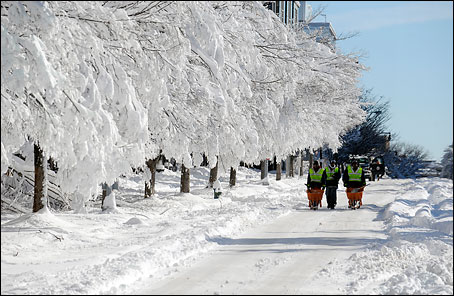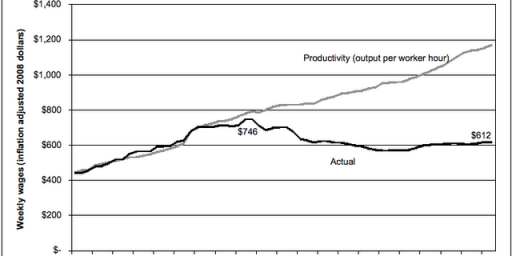Federal Government Closes, Resentment Ensues
 Shocking no one who lives in the area, OPM Director John Berry announced late yesterday afternoon that the Federal government would close its offices in the National Capitol Region today because the fallout from the weekend blizzard would make travel unsafe. Given that this is the area’s worst snowfall in recorded history and that a large portion of the workforce commutes from quite some distance — and that the Metro system is all but shut down, stranding even locals — it was a no brainer.
Shocking no one who lives in the area, OPM Director John Berry announced late yesterday afternoon that the Federal government would close its offices in the National Capitol Region today because the fallout from the weekend blizzard would make travel unsafe. Given that this is the area’s worst snowfall in recorded history and that a large portion of the workforce commutes from quite some distance — and that the Metro system is all but shut down, stranding even locals — it was a no brainer.
The consequences are, of course, significant and factored into the decision:
He convened a conference call with local and state government and transportation officials Sunday afternoon during which they determined a Monday morning commute would be too unsafe, officials said.
Despite Monday’s operating status, emergency personnel must still report as necessary.
The decision also means a day off for most of the region’s private sector, which uses the federal government’s operating status as a guide. Virtually all academic institutions in the region will also shutter on Monday.
Closing the federal government for one day costs taxpayers roughly $100 million in lost productivity, a price tag Berry said weighs heavily on his final decisions.
Jokes about lazy civil servants aside, I’m always dubious about claims of “lost productivity” since, for most office workers, the job’s still got to get done. Projects due on March 15 will still get turned in March 15, which means people will have to pick up the slack somehow for the missed day(s).
And, yes, people in other parts of the country manage to drive in similar or worse conditions. But their local governments are prepared to plow and sand/salt the roads in a way that the DC region isn’t. And people tend to have snow tires or snow chains and know how to drive in severe conditions.
There have already been a ridiculous number of accidents over the weekend, as people who either had to get somewhere or were too stupid to stay home got out and wrecked their cars. It would be idiotic to order people in to work today under the circumstances.
But none of this is enough to sway the detractors, who’ll bitch about how this shows America is getting soft or federal employees aren’t willing to put in an honest day’s work.






Based on what I hear on the MARC platforms in the morning, half the feds telecommute at least one day a week or on days they have to stay home for whatever reason.
I didn’t bother to make the trip Friday because it would have been 3-4 hours of work and then coming right back to Baltimore when everyone panicked and hit the Metro and Union Station at the same time. I still worked all day long and on into the weekend without leaving home – same deal for today even though the office is closed.
The detractors deserve to get snowboarded.
I live in a neighborhood full of civilian and military personnel outside Baltimore, near Ft. Meade. We can’t get out of our driveways to the roads, there’s over 30 inches of compressing snow and ice and no snowplows in sight!
A kind neighbor (my husband) was out until well after 9:30 last night with our little 26″ snow-thrower (the kind you do your driveway with, that you walk behind) digging out a small cul-de-sac, with at least a single car width to get in and out.
Three other neighbors did the same to a longer cul-de-sac with a smaller snow-thrower and shovels.
Saturday night, the same group were out trying to get a single track cut in the main access road to our area because a neighbor’s father started to have chest pains after shoveling a bit.
We were working from when the storm started to finally slack off (around sunset) until about 10pm. The man is fine now, but there was no way an emergency vehicle was going to make it to their house. Not with 39 inches of snow in the road. And yes, it did take that long to dig through.
Many major roads are STILL impassible to anything without 4-wheel drive. This is NOT Buffalo NY, Cleveland OH or Chicago IL, we are on the edge of the usual winter snows. Some years it is only a dusting at best. This is a major event that even Cleveland would have to take an extra day or two to dig through.
These guys are all federal employees, two work up here, one at NSA and my husband out in Linthicum, the other two are somewhere in D.C. The highways are still dangerous, and the trains are not running.
Just HOW do you expect the average Gov. employee to get to work??? We aren’t Nancy Pelosi or Ben Cardin, we don’t get “official vehicles and drivers” complete with “personal snow plow escorts” leading the way.
Having lived through the Blizzard of 1978 in Cambridge, Mass., I have very little patience for anyone who would say a blizzard in a place not equipped to handle one is no big thing. To give you some idea of what the ’78 blizzard was like, in a part of the country used to very large snowfalls:
When the snow subsided, National Guard APCs went out to Rt 128 to rescue people from their snowbound cars. Many folks spent a week or more in shelters before they could return home. The Boston area was shut down for a full week. One could not travel into or out of the city area unless you could prove you had a very good reason, e.g., were medical personnel in route to a hospital.
The aftermath of such a storm may look pretty, but the reality is quite ugly.
I had the fortune/misfortune of holding jobs that were considered ’emergency’ during my DC assignments. I had the greater fortune of actually living within walking distance of my job, so snows–like the ice storm of 1991–were minor inconveniences. Not so for my staff, though, many of whom lived in the outer VA and MD suburbs. They simply could not get in and Uncle wasn’t coughing up helicopters for their commute.
That meant that those who could get in worked longer hours because the work needed to be done ASAP, not ASAP+1. Some of these benefited from overtime pay; others, deemed management, just sucked it up.
Coincidentally, I was up in the Boston area in ’78. I was driving the then-considerably-smaller ’76 Honda Civic and it handled the snow incredibly well. The only time I ran into trouble was when I followed a snowplow a little too closely and the roadway got glassy. Driving a bit further back handled that.
Consider that concept of $100 million in ‘lost productivity’ if we closed down DC for a day. That works out to $36.5 billion to close DC for the year (or under $26 billion if we ignore weekends and holidays).
The mind boggles at the potential benefits to the country at such a comparitively low cost.
And, yes, people in other parts of the country manage to drive in similar or worse conditions. But their local governments are prepared to plow and sand/salt the roads in a way that the DC region isn’t. And people tend to have snow tires or snow chains and know how to drive in severe conditions.
This in the end is why it is wise to close things down.
I would imagine a lot of smallish towns and cities in areas where snowfall is common have more snowplows and drivers on hand to drive them than the DC area. It just isn’t worth the cost to sink money into a fleet snowplow in an area that sees little snowfall. The money would probably be better spent on extra fire trucks.
And even in places where there is a lot of snow, there are sometimes closings-although the closings come during the storm-not in the days after.